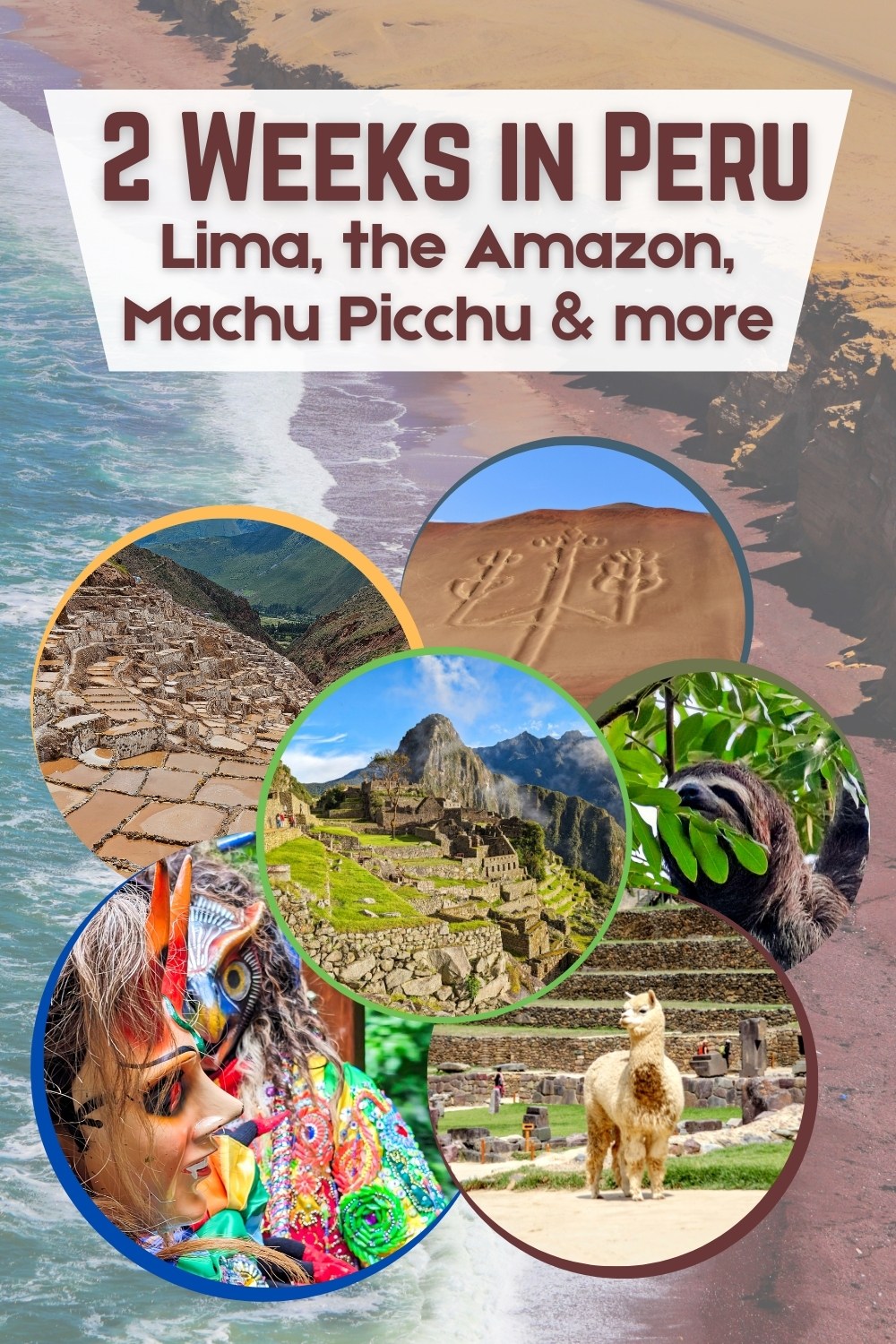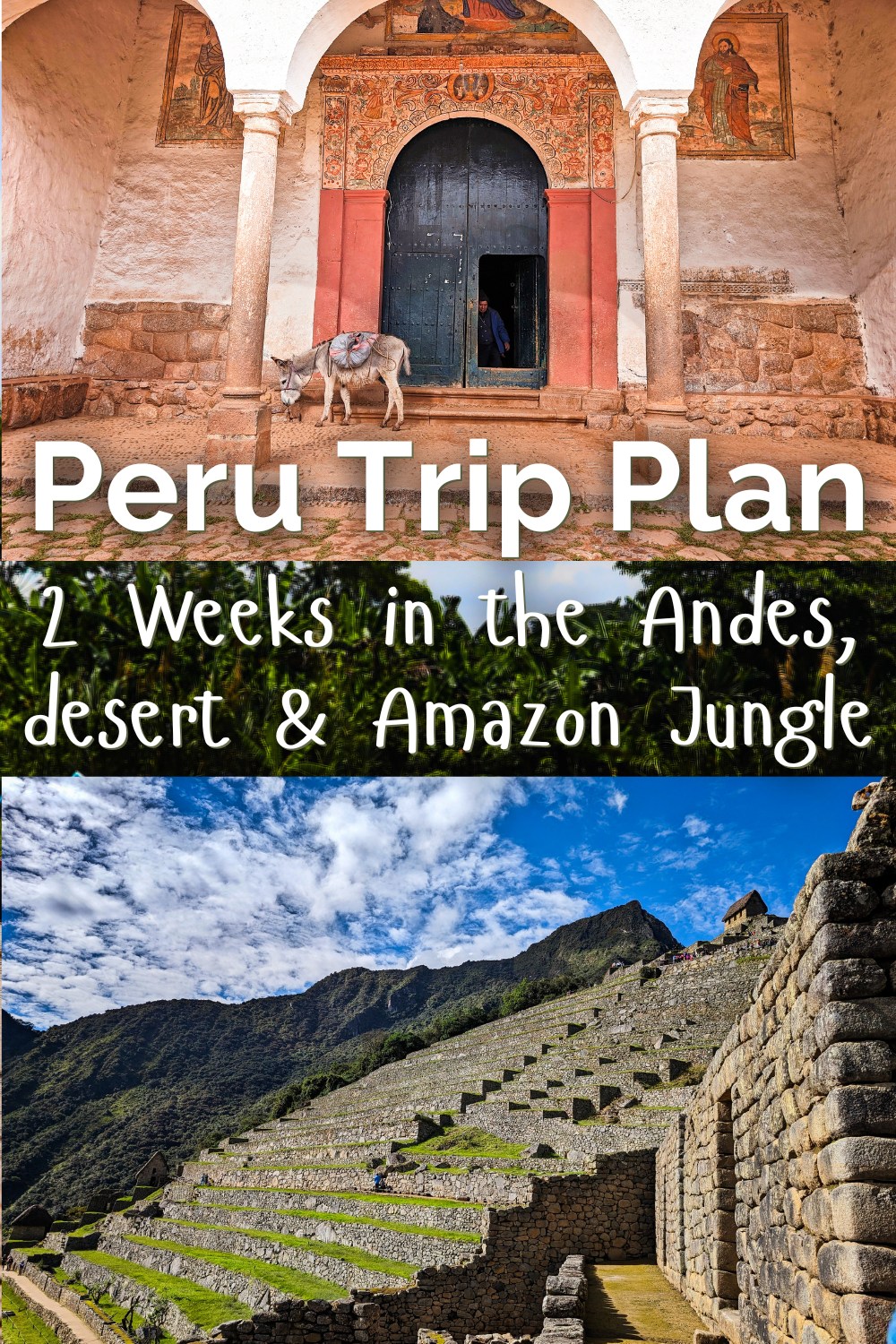Save this two week Peru itinerary for your first trip to this amazing country! We had an unforgettable experience in Peru, from Lima to the Andes to the desert to the Amazon. This Peru itinerary is doable with kids, or just adults, but it all depends on what you want to see most and how much time you have for your Peru trip.
For us, we built out this two week Peru itinerary based on the things our kids had researched and told us were most important to them. I’ve got to say, they hit the nail on the head for what us adults were interested in too. Running with their list, I built our whole itinerary and where we stayed to make sure we had the best time, enjoying the most interesting experiences possible for two weeks in Peru.
If you have any questions about logistics, our Peru itinerary and how to adjust it, or want to leave your own tips for how to have an incredible experience, please leave a comment or send us a note. We’re always happy to share more!
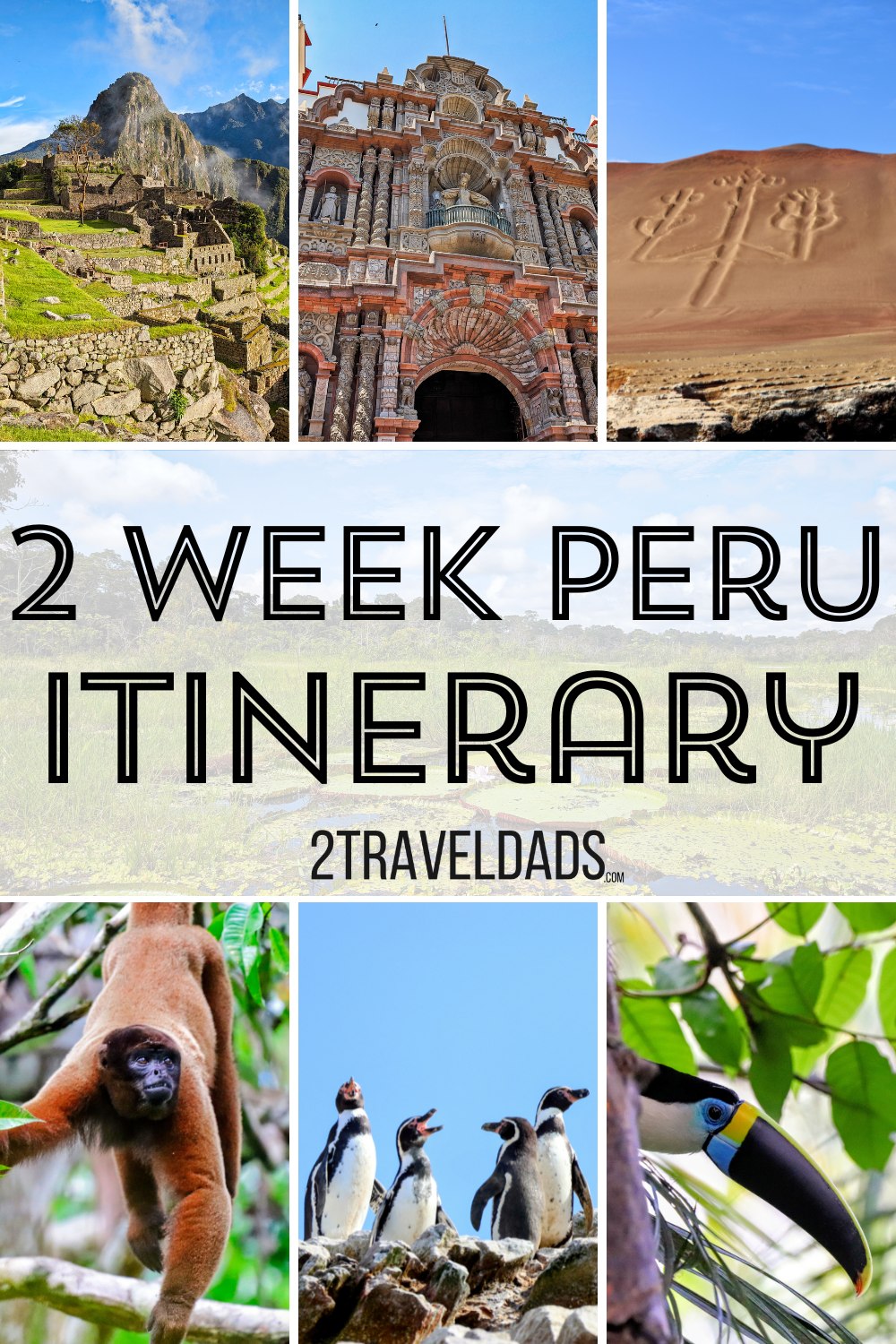
Getting to Peru from the USA
I was surprised how easy it was to get from the USA to Peru for our trip. If you have a USA passport you don’t need a visa and Peru customs is very easy to go through. Be sure that you have at least 6 months of validity left on your passport and that you’re ready to say exactly where you’re going, where you’re staying and when you’re leaving. That should be good to get through customs swiftly. You can visit for up to 183 days.
Other nationalities that don’t require visas include:
- All South American nations except Venezuela
- Canada and Mexico
- Most central American and Caribbean nations
- South Africa
- Israel
- All EU countries plus Britain, Norway, Belarus and Russia
Visa entry or not, you do need to be able to prove you’re going to leave Peru at some point. “Continuing travel” is very important to be able to communicate or prove when you go through customs. A lot of people who are doing slow travel for their Peru trip will pop into Bolivia to the south to refresh their visitation clock. This is NOT an option for USA passport holders as Bolivia requires a visa for US citizens (but not most others).
To fly to Lima from the USA, you have a few options:
- Miami, Florida – MIA and FLL
- Los Angeles, California – LAX
- New York City, New York – JFK and EWR
- Houston, Texas – IAH
- Atlanta, Georgia – ATL
You’ll be surprised how inexpensive flights to Lima are, including the mileage exchange deals you can get from the USA to Peru. Listen to our podcast episodes about Using Points for Travel or Mastering the American Airlines Loyalty Program
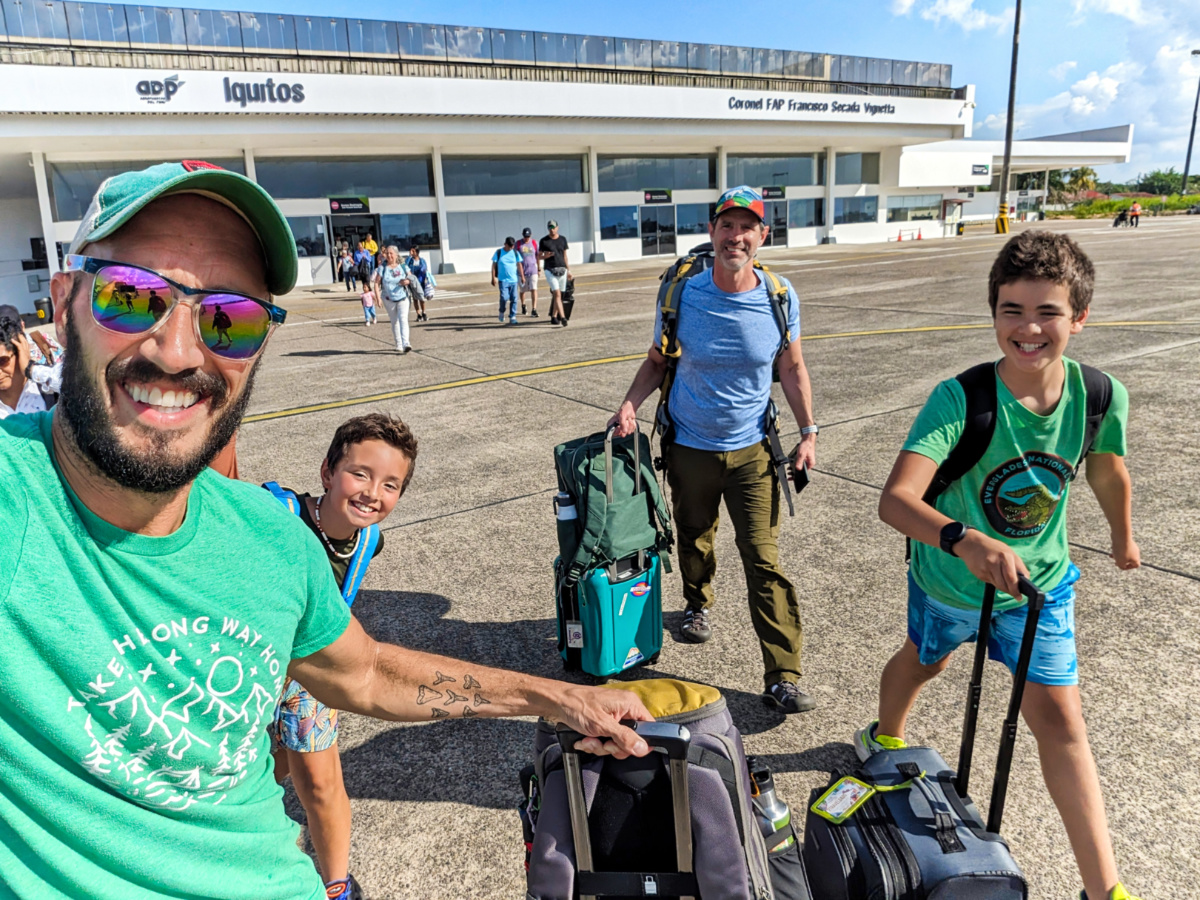
Regions to Visit in Peru
Peru is a pretty large country, which includes 80+ of the 126 microclimates on earth. Visiting Peru means seeing the full spectrum of landscapes and ecosystems, whether you’re into science or not. There are six main areas visitors for the first time in Peru might plan on visiting:
- Lima – the capital city and historic center
- The Andes Mountains – Cusco / Machu Picchu / Sacred Valley
- The Andes Mountains South – Lake Titicaca / Arequipa / Colca Canyon
- Ica – Paracas / Ballestas Islands / Ica
- Southern Peru – Nazca Lines / Atacama Desert
- The Amazon – both the Jungle and the River itself
For a first time Peru trip, I would actually recommend keeping it simple and sticking close to sea level. The elevation of Cusco and the Sacred Valley really does have an impact on visitors, especially ones who live at sea level. We’re well traveled, healthy, and pretty resilient, but the altitude sickness hit us so hard that we were fairly miserable for most of our time in the Andes. We were careful and thoughtful, but still suffered intense vomiting, diarrhea, headaches and absolute fatigue. We actually changed our plans to get back to sea level ASAP because it was so intense. Just keep this in mind as you plan your first trip to Peru. Check out our tips for Preventing Altitude Sickness
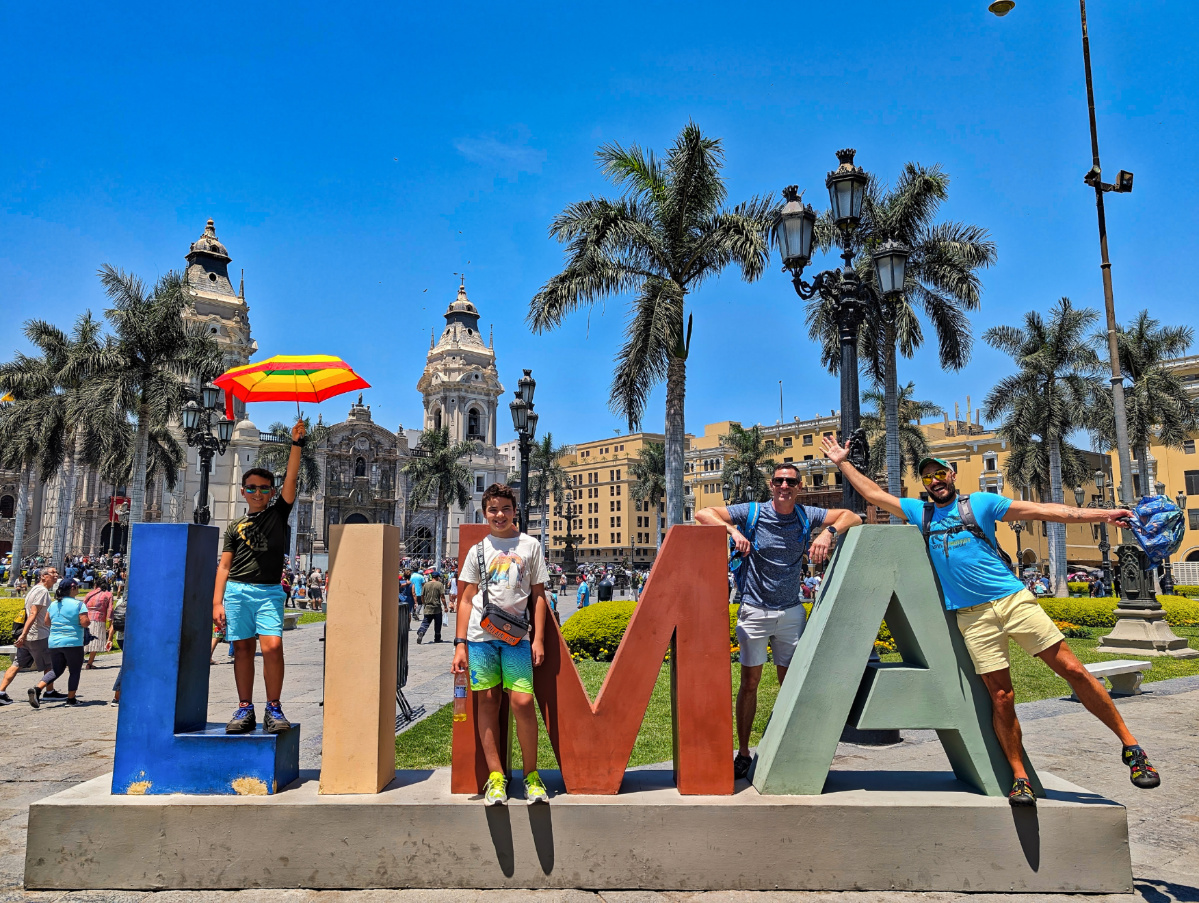
Planning a Peru Trip Podcast Episode
We have several Peru podcast episodes including All About the Andes; Peru at Sea Level – Lima, the Desert and Islands; and the Peruvian Amazon! In our Peru trip planning podcast episode:
- Why Peru?
- Our transportation throughout Peru
- Itinerary highlights from Machu Picchu to seeing penguins and monkeys
- Tips for making the most of your Peru trip
Travel Within Peru
When building our Peru itinerary, travel within the country was the thing that was the most confusing to me initially. You can look at things on a map until the cows come home, but understanding the logistics of getting from place to place is a whole other thing. Before building our travel plan we’d heard about trains and a great bus system… Yeah, no. Those options are very limited and specific, and not a national thing.
There is NOT a train network in Peru. There is a train between Machu Picchu town, aka Aguas Calientes, and Ollantaytambo, or the train goes all the way to Cusco in the dry season. You cannot travel from Lima to Cusco or Pisco via train. The train to Machu Picchu town is awesome though, and you’ll love the scenery and experience as a part of your Peru trip.
Get train tickets to Machu Picchu!
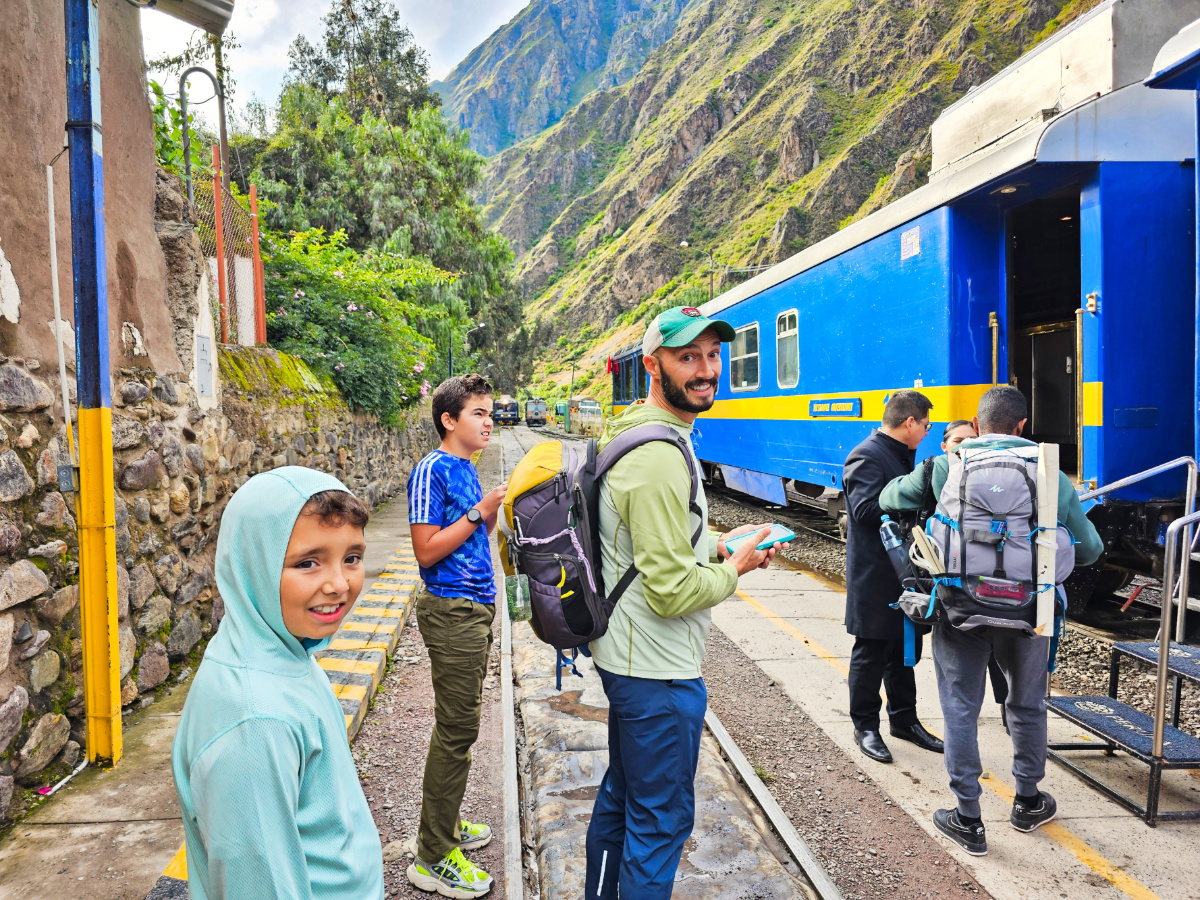
There’s also not an extensive bus system to go beyond Lima, but you can book tour bus passes from Lima up into the Andes, to Arequipa and Cusco. Buses will get you where you need to go with some extra time, but it’s not just a simple bus ride on an afternoon. This is the way to go to slowly, working your way up in elevation, but it’s not a convenient, time-saving sort of transportation.
Get bus tickets from Lima -> Cusco
The regular visitor to Peru probably will need to fly between destinations, or get a rental car. Driving in Peru isn’t weird or scary, but driving in Lima is an absolute nightmare. Between the intense traffic and the aggressive blinker-less road rage, it’s one big anxiety attack. Once you’re on the PanAmerican Highway though, it’s smooth sailing and one of the best roads we’ve driven anywhere in the world. Driving to Arequipa, Cusco or Ollantaytambo is not bad, so if you’re comfortable and confident, go for it.
When it comes to flying, getting to Peru is easy (see above) and once here you’ll be surprised at the ease of travel. From Lima, you can easily fly to Iquitos (the Amazon), Cusco (Machu Picchu/Sacred Valley), Arequipa (colonial area/Colca Canyon), Chiclayo (northern coast), Juliaca (Lake Titicaca) and more. LATAM flights are consistent and are inexpensive for regional travel. You will pay more than a bus ticket, but you will save whole days in travel, allowing you more specific experiences that transportation during your Peru trip.
See regional Peru flights on LATAM
Need to Know to Visit Peru
There are a few things to know before you visit Peru, just because it really is different than the USA or Canada. If you’ve traveled in South or Central America, this might not seem unusual to you, but if this is a first for you, pay attention:
- The money is the Sol or Soles (multiple; said “sole-ais”) – it’s about 4 soles per US dollar (Spring 2024 exchange rate)
- The primary language is Spanish, with Quechua being second, and then a lot of people working in tourism speak English. If you ALWAYS attempt to use Spanish as best as you can before just speaking English, as that’s most polite and sets you up for the most successful conversation.
- When you use a toilet in Peru, any paper does NOT go into the toilet. There are trash cans by toilets for the waste paper, no matter how you think it’s just fine to flush it.
- Wherever you go, you should always bring your own TP. Yes, it is sometimes provided but also more often than not there will not be toilet paper in public restrooms, even when you pay the common 2 soles to use the restroom.
- There are LOTS of potatoes in Peru no matter what region you’re in. You’ll get to try lots of different potato varieties and preparations, so even if you’re not into potatoes, keep an open mind.
I’m sure there are more helpful things to keep in mind before visiting Peru, but these are the things that really stand out to me as unique and important for a great Peru trip.
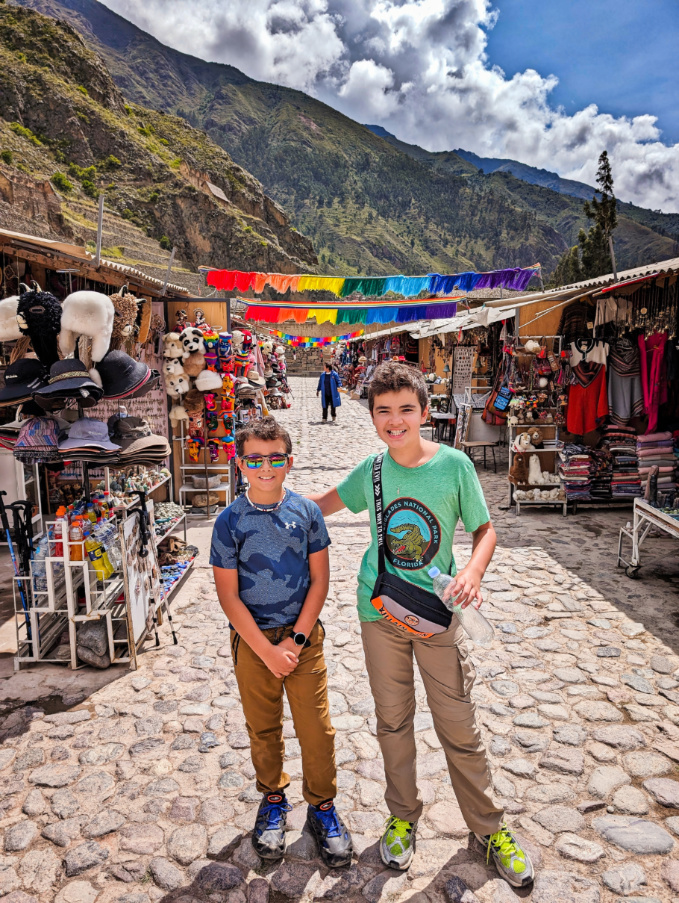
Two Week Peru Itinerary
Now it’s time to get into our two week Peru itinerary. We’ve got a great plan that includes the Andes Mountains, Lima, the desert coast, and the Amazon rainforest. You’ll love it! As you look at our Peru itinerary and start planning, keep in mind that if you can add four more days, you can take your time ascending up into the Andes, which will be very helpful to acclimate.
Begin in Lima, Peru
Since you’ll be flying into Lima, Peru from nearly anywhere you’re starting, you should plan to spend a few days exploring Lima. It’s a really cool city with lots of history and beautiful buildings, so you’ll enjoy having time here to get used to being in Peru. I don’t recommend getting a rental car for your time in Lima, as driving here is a stressful and horrifying experience (worse than Mexico, France or Croatia), but you can easily use Uber to get wherever you need.

Historic Lima Sightseeing
Lima has more people than New York City, so keep that in mind as you’re exploring. The historic core is less densely populated, but still crowded. We visited during Semana Santa (Easter week) and it was so very busy, with long lines to get into the historic churches. Any other time of year you should have no problem visiting historic religious sites throughout the day, but during Easter and Christmas you’ll see that the areas directly surrounding the famous churches are very crowded. Plan your Peru trip to fall just before or after major religious holidays.

How can you get around the issues with crowds? If you book a walking tour, many of the guides have the correct license to be able to detour away from crowds and enter churches that are a part of their tour, including the Cathedral of St Francis where you’ll find the catacombs. You can visit places like the Plaza Mayor or Hotel Bolivar on your own, and the churches too, but it’s much easier with a guide.
We did a historic walking tour of Lima with Lima Experience. Our guide, Joseph, was great and spoke excellent English. He was able to field questions from the kids and explain so much of what makes Lima and Peru the interesting, diverse place that it is today.
If there’s one museum you must visit in Lima, it’s the Larco Museum. Not close to the historic core (a 20 minute Uber ride), the Larco Museum has the most incredible collection of Inca and pre-Inca artifacts in Lima. There is the Inka Museum in Cusco that is larger and more comprehensive with grand exhibits, but the Larco is where you’ll find golden Inca artifacts, aisles and shelves of figures and pottery, and the very unique… adult section of Incan art and artifacts. Yes, it’s what you are picturing and there are some fascinating pieces depicting all varieties of intercourse, human anatomy and birth. The Larco Museum is really a wonderful addition to your Peru trip.
Get advanced tickets for Larco Museum

Neighborhoods to Visit
The most popular neighborhoods that are good for tourists to visit in Lime include Miraflores (we stayed here), the historic downtown and Barranco neighborhoods. These are good neighborhoods for getting the vibe of life in Lima for a few reasons:
- They are more upper class residential, meaning well maintained with good pedestrian access
- There are lots of cafes and restaurants for eating Peruvian foods
- Because they’re known for being tourist friendly, they are diversely populated and welcoming
- There are parks and plazas that you can enjoy, and lots of murals around the neighborhoods.
There are more parts of Lima than these, but when it comes to being able to easily access parts of the city, these three neighborhoods are the easiest and most vibrant. I don’t recommend driving in Lima (it’s intense, as I’ve said) so taking an Uber wherever you need to go that’s not walking distance is a good idea.
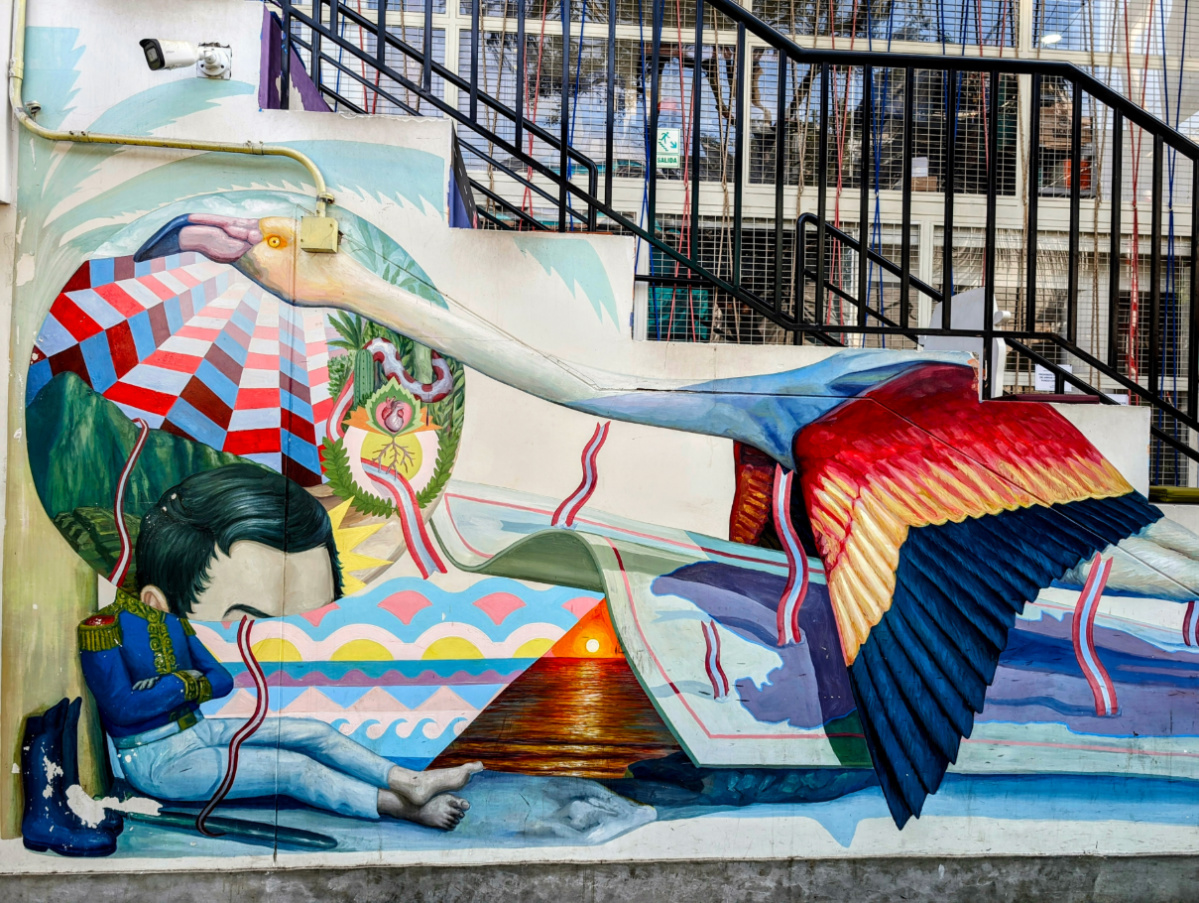
Exploring the Andes Mountains
Before thinking about Lima or the Amazon, most people are excited to visit Peru to go to Machu Picchu. For many, their knowledge of Peru stops at “That’s where Machu Picchu is.” There’s so much more to the Andes than this one site. There are actually many Inca and pre-Inca sites from the mountains just south of the Amazon all the way to Lake Titicaca and into Bolivia and Chile. For our two week Peru itinerary, we are focusing on Machu Picchu and the most famous sites in the state of Cusco.
We have our Andes stops in order of how you can do them to gradually increase your elevation, so hopefully that’ll help make the experience better for you.
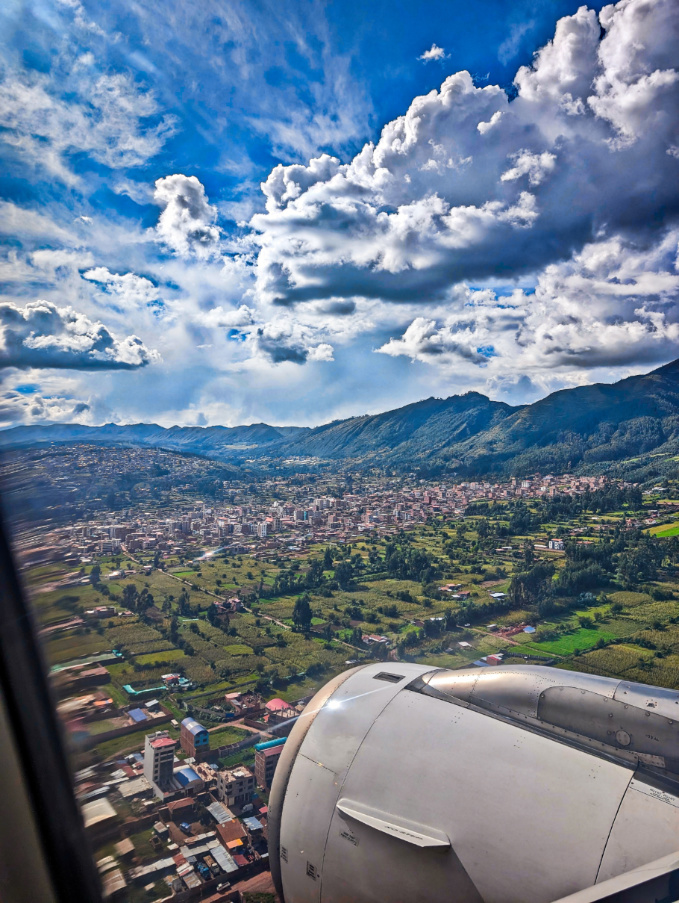
Listen to our Andes podcast episode to hear about our stops and activities. This part of the trip was fun, but also a struggle.
Reality of Altitude Sickness in the Andes
Most of us don’t live at high altitudes like you’ll face in the Andes mountains. We live at sea level in Florida, so aren’t used to the elevation, despite doing mountain trips throughout the year. When you visit the Peruvian Andes, the elevation ranges from 6,693 feet in Aguas Calientes (Machu Picchu Town) to 12,556 feet at Puno (Lake Titicaca). If you’re visiting the famous Rainbow Mountain area, you’ll go even higher to 17,060 feet. That’s 3k feet higher than the summit of Mount Rainier!
The altitude really does have an impact on the human body, so you should be cautious as you plan your travel to the Peruvian Andes. After 5k feel you may feel like you’re huffing and puffing when you go up stairs. At 8k feet your insides feel a bit weird and have a difficult time processing food as usual. Higher than that and you become dehydrated easily in addition to the other side effects. All this can present as fatigue, dizziness, nausea, vomiting, diarrhea and more. We suffered headaches, fatigue and horrible vomiting and diarrhea during our time in the Andes, and we only made it as high at 12,163 feet up.
While not everyone suffers from altitude sickness, there are ways to prevent or mitigate it:
- Ascend from sea level as gradually as possible, staying a few nights at different higher elevations
- Drink LOTS of water and get solid rest
- Take it easy while you acclimate
- Eat small meals, especially as the day winds down
- Don’t drink alcohol, but DO drink coca tea and suck on coca candies
- Keep your overall Peru trip joy in mind when deciding if you want to tough out the elevation
For some travelers, there is a pill you can take called Diamox that helps acclimate to the altitude. THIS IS NOT AN OPTION FOR EVERYONE, SO TALK TO YOUR DOCTOR. This was not an option for our family due to some medical stuff, but it may work for others. Everyone told us just to get it, but upon research and talking to our family doctor we discovered that it could be a very dangerous situation for us, so I’m glad we didn’t just jump into taking a pill without getting info from our trusted medical professional.
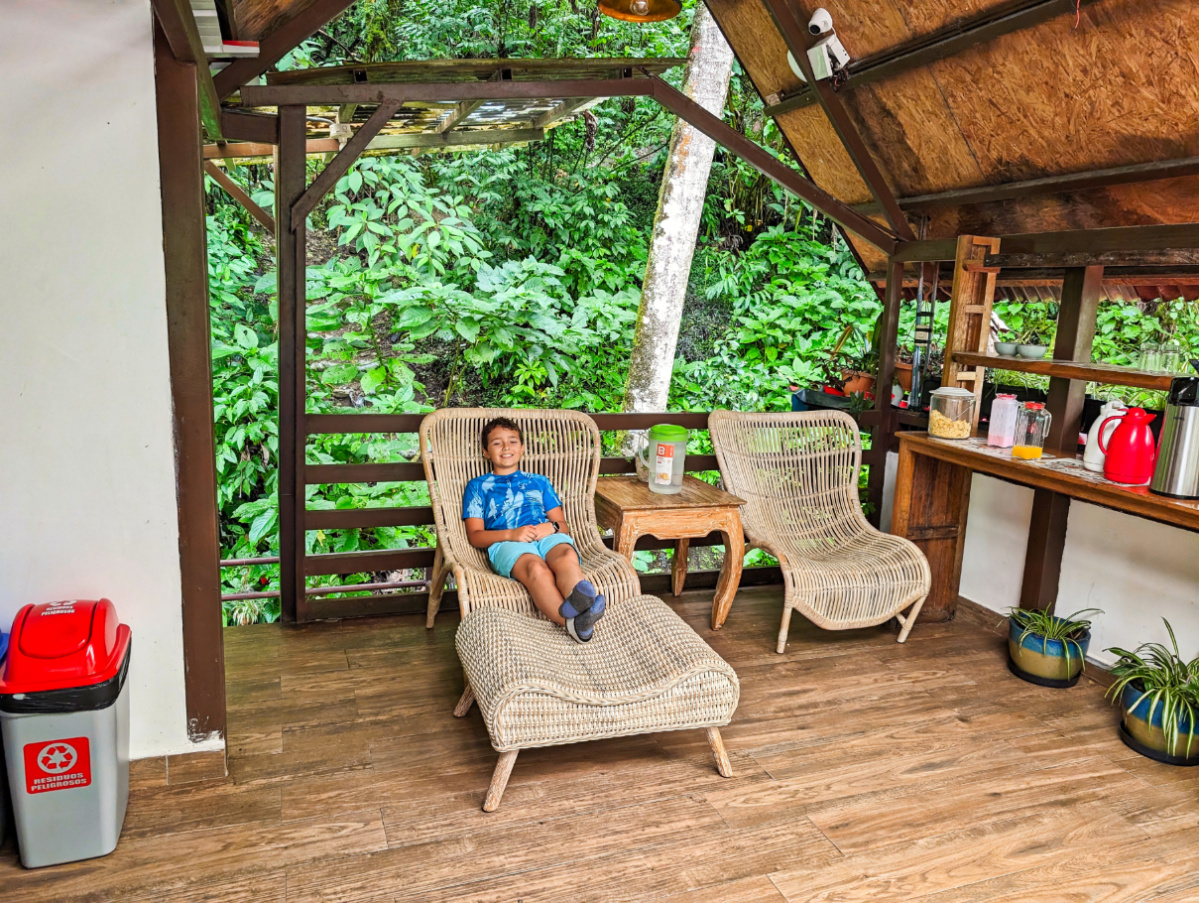
Visiting Machu Picchu
To start, you can either take the bus over several days from Lima up to Cusco, or you can fly into Cusco and then travel to Aguas Calientes, aka Machu Picchu Town. If you have the time to take the bus, do it! To stick with our two week Peru itinerary, you’re flying to Cusco (CUZ). With this, the best option is to immediately exit the city and make your way to Ollantaytambo to catch the train to Aguas Calientes.
Note: during the dry season of April – October you can start the train journey IN Cusco, but during the rainy season the train route is only from Ollantaytambo to Aguas Calientes due to landslides that frequently happen during the rain. This just means you need to plan your Peru trip properly to get the train in the correct town.
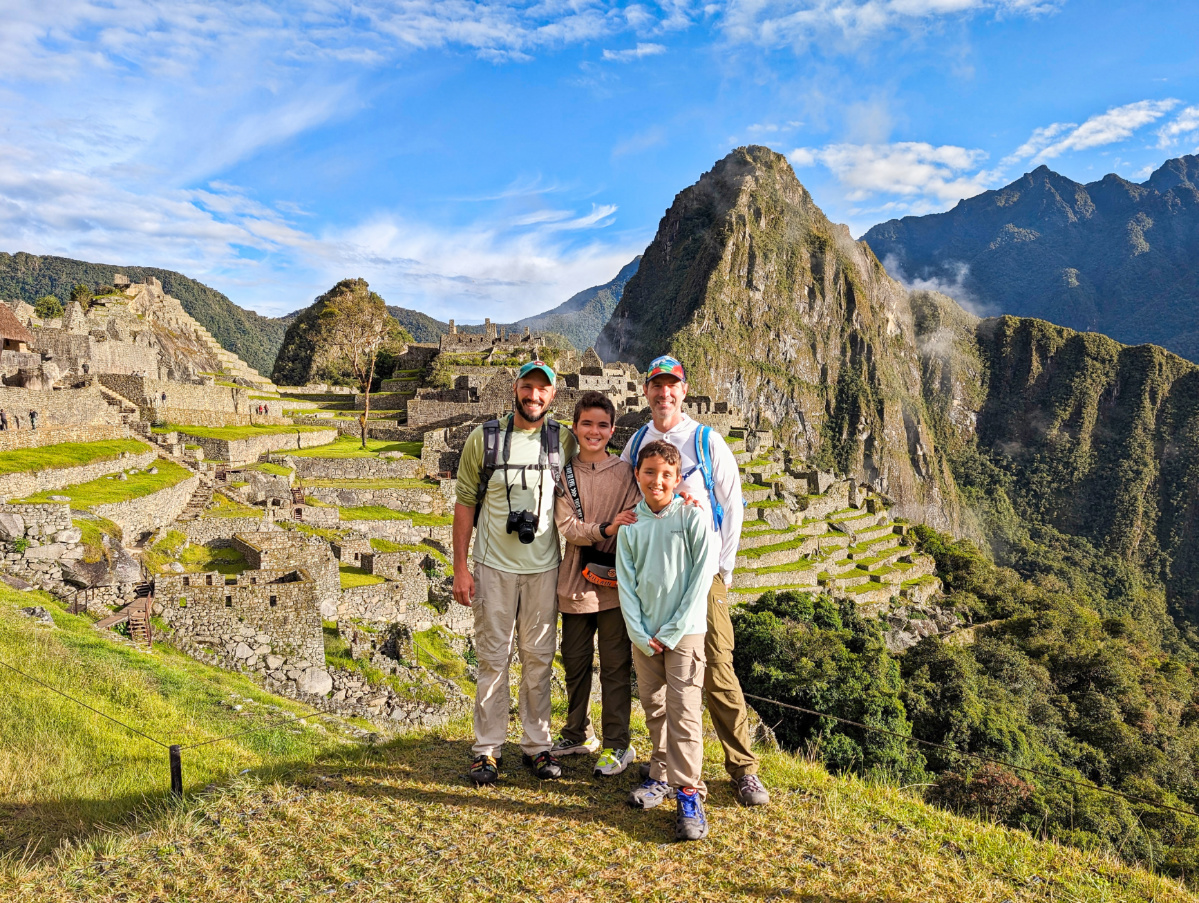
Get train tickets to Machu Picchu!
For visiting Machu Picchu, you will need to get your entry tickets IN ADVANCE. Entries to the archaeological site sell out days or weeks before, so as soon as you know when you’ll be there, secure your tickets. We missed out on getting tickets for ourselves and had to book a private tour, as registered guides have access to additional entries. This turned out to be FANTASTIC as our guide, Percy with Wonders of Peru Expeditions was amazing. He was so knowledgeable and very patient with us, both for our questions and our struggles of climbing stairs at such high elevation.
Book our exact Machu Picchu tour here!
Be sure to bring water, snacks, sunblock and ponchos for visiting Machu Picchu. Once you enter the site there are no services and umbrellas are not allowed. You’ll need to be self-contained and ready to brave the elements as the weather can change quickly. If you arrive early, you have great chances of getting a beautiful day at Machu Picchu, because even if there are clouds to start, they’ll probably clear and you’ll have at least a few moments of sunshine.
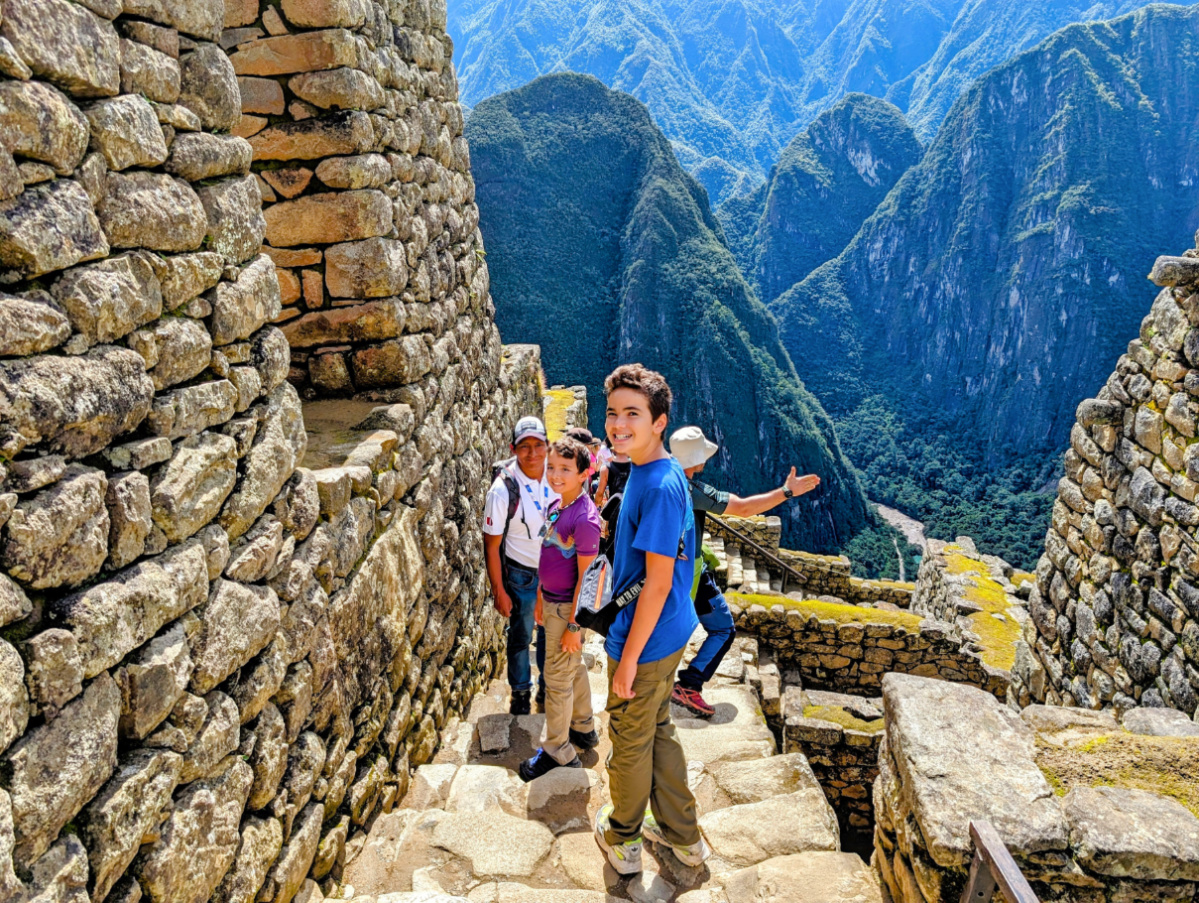
Touring the Sacred Valley
I actually enjoyed our time in the Sacred Valley more than visiting Machu Picchu. This part of the Andes is one of the coolest parts of our two week Peru itinerary. Here you’ll get to see really neat, old towns built by both the Incas and pre-Inca civilizations. There are farms, rivers, plateaus, narrow cobblestone streets, and awesome people. If you choose to rent a car in Cusco and drive yourself, you can take several days exploring the Sacred Valley and really taking your time.
You can also see most of the Sacred Valley sights on a guided tour with a driver. I know, I’ve already recommended two other tours during our two week Peru itinerary, but it’s because here in the Andes and in such historic places, having a specialist who knows infinitely more than we did made each experience exceptional. For our Sacred Valley tour, we spent a very long day with Oscar from Exclusive Inka Tours. He was such a wealth of information and was great with our kids.
Book our exact Sacred Valley tour here!
The main sites to visit in the Sacred Valley include:
- Ollantaytambo Archaeological Site and town
- Moray Incan horticultural laboratory
- Salinas de Maras salt mine – amazing!
- Pisac Archaeological Site and town
- Chinchero Inca town and historic sites
- Mountain View restaurant and llamas
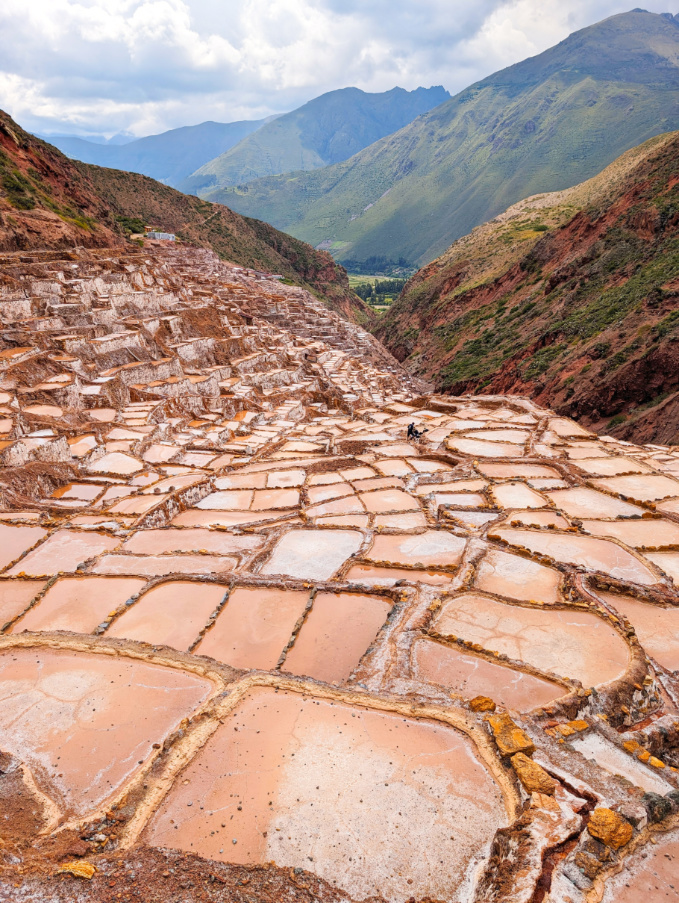
There are more sites to visit, including more archaeological sites, but either doing a tour to cover ⅔ of these spots or spending two days to explore the Sacred Valley on your own is wonderful and will give you a comprehensive visit. This may just be one of your favorite parts of your Peru trip.
Tip: you can purchase a multi-site ticket to cover the Peruvian archaeological park sites and get a bit of a discount. It’s time limited though, so you may need to manage yourself well to be able to get the full value of the ticket (valid 2 days for adults, 10 days for child tickets).
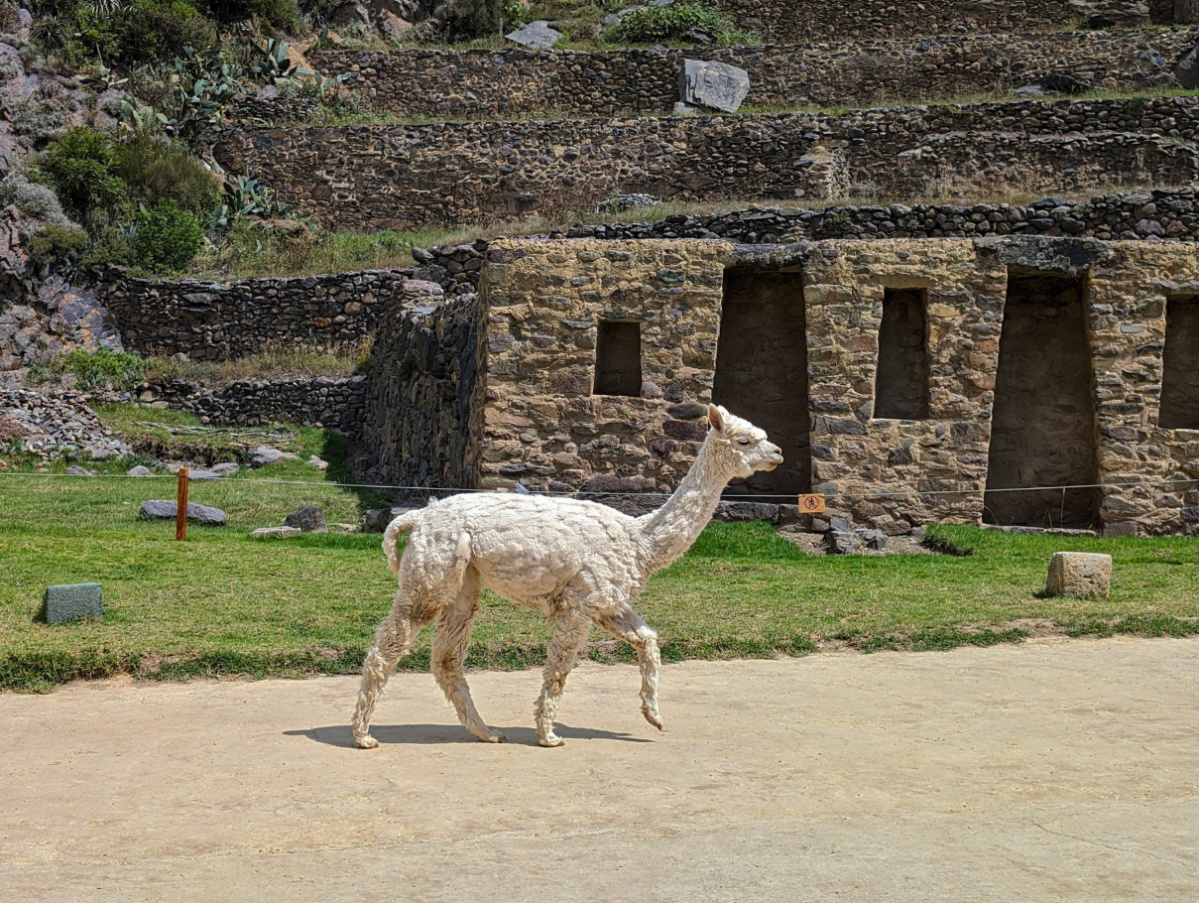
Cusco and More Andes Sightseeing
Cusco is the former capital of the Incan Empire and is one of the most unique cities we’ve been to. The colonial structures are built on top of Incan structures, such as churches built on top of palaces… Cusco is big and densely populated. Because the city is built into the hills and valleys, the streets zigzag their way to the valley floor. There are staircases and flood gutters everywhere, and in the historic core, the streets are tight!
While in Cusco, take it easy as it’s higher in elevation than Ollantaytambo or Aguas Calientes. Spend your time checking out the main historic area around the Plaza de Armas and visiting the Inca Museum, the Historical Museum of Cusco, the cathedral, the Museum of Pre-Columbian Art and more. There is a really cool aqueduct, el Acueducto da Sapantiana, more Inca ruins at Saqsaywaman, Q’enco and others. Cusco is really cool and you can easily spend three or four days here. Before arriving we didn’t realize just how many ruins and archeological sites in Cusco you can visit.
Note: we had to cut our time in the Andes short and skipped most of Cusco because we were suffering from altitude sickness so badly. In any scenario, it’s okay to adjust your travel plans if you’re physically suffering and need to move on. Don’t feel bad about it.
More Andes destinations to add if you have time and are feeling good:
- Puno (highest Andes) and Lake Titicaca
- Rainbow Mountain / Montana Vinikunka
- Colca Canyon for the Andean condors
- Arequipa (low Andes) – for a longer trip to sea level or onto Bolivia

Ica – Where Desert Meets Sea
Never have I ever… been so excited to be back at sea level. After an intense week in the Andes, being back at sea level was such a welcome change. We immediately felt better upon landing in Lima and driving to the state of Ica. Getting out of Lima takes at least an hour (remember, it has more people than New York City) but then once you’re on the Panamerican Highway it’s driving bliss!
Note: ALWAYS DRIVE WITH YOUR LIGHTS ON. You will get pulled over or held back at a checkpoint and ticketed if you don’t have your lights on. We got pulled over and were being cited for 1300 soles… and then the police officer offered us a cash discount on the ticket if we could pay on the spot. Yes, exactly what you’re thinking – IF WE GIVE THE OFFICER CASH WE WON’T GET A TICKET. It was a bribe. Good times.
As your using out two week Peru itinerary, this is a great part of the trip to add time, particularly if you cut some time from the Andes. The Ica region is awesome and NOT what you’re expecting to find during your Peru trip!
Listen to our Peru Itinerary Planning podcast episode to hear about Ica and how we scheduled our time.
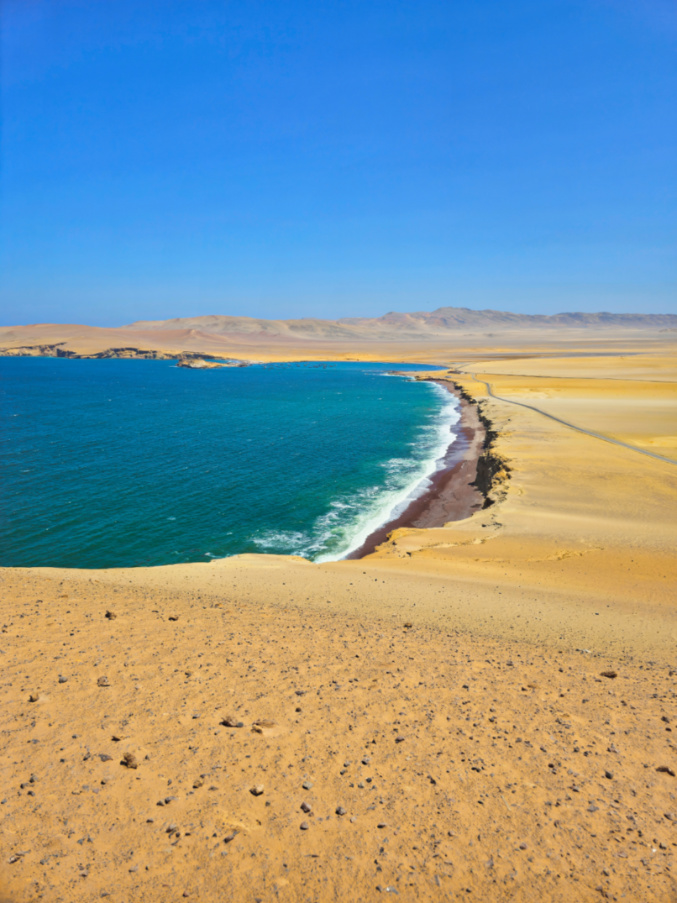
Paracas – Peru Beach Days
I love Paracas! Of all the towns and cities in Peru that we visited, Paracas was my favorite. Maybe it’s because we live in a beach town or maybe because for me it’s nostalgic of Cabo San Lucas or Puerto Morelos in Mexico, but I loved it. The town is full of small restaurants, ceviche and cafes. There are Peruvian coffee shops and little markets. The waterfront has a promenade and a beach.
Visiting Paracas is a complete vibe change over the Andes or Lima. It’s a breath of fresh air and relaxation. While it isn’t as built up and fancy as most Mexican beach towns, Paracas is well maintained with lots of beautiful murals and shops. And it’s home to the largest inflatable water park in South America. Yes, you read that correctly.
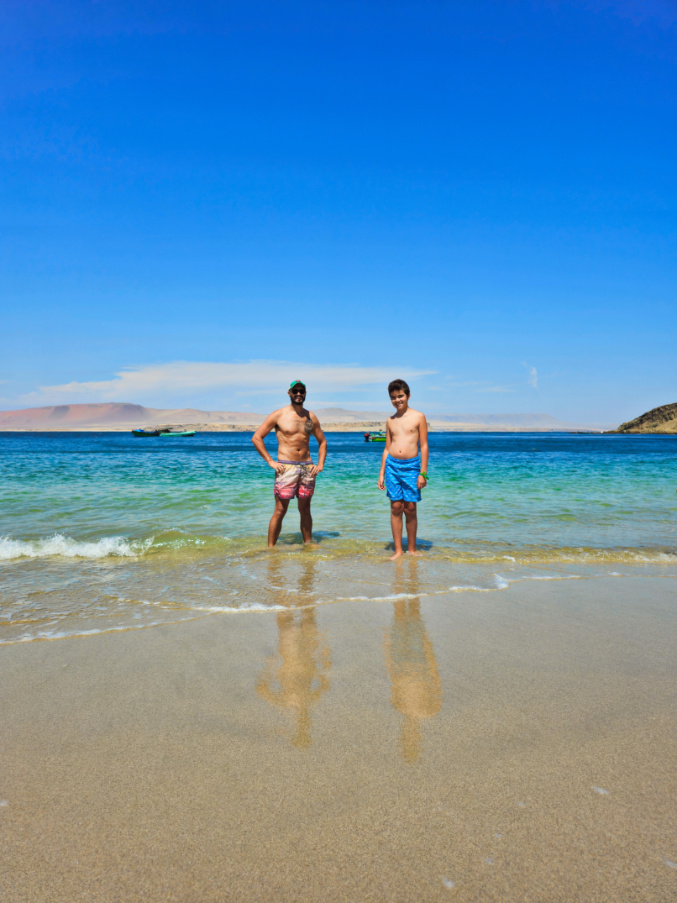
We usually opt for historic sites and nature over any sort of modern or kitschy activity, but after a week in the Andes and still being in recovery mode, when we walked onto the beach and saw Yakupark (an inflatable water park / giant obstacle course) we decided it would be good to just do it and chill. The kids had the best time and needed this sort of wild and fun activity.
Why are most people coming to Paracas, Peru though? For the PENGUINS!!! (keep reading)
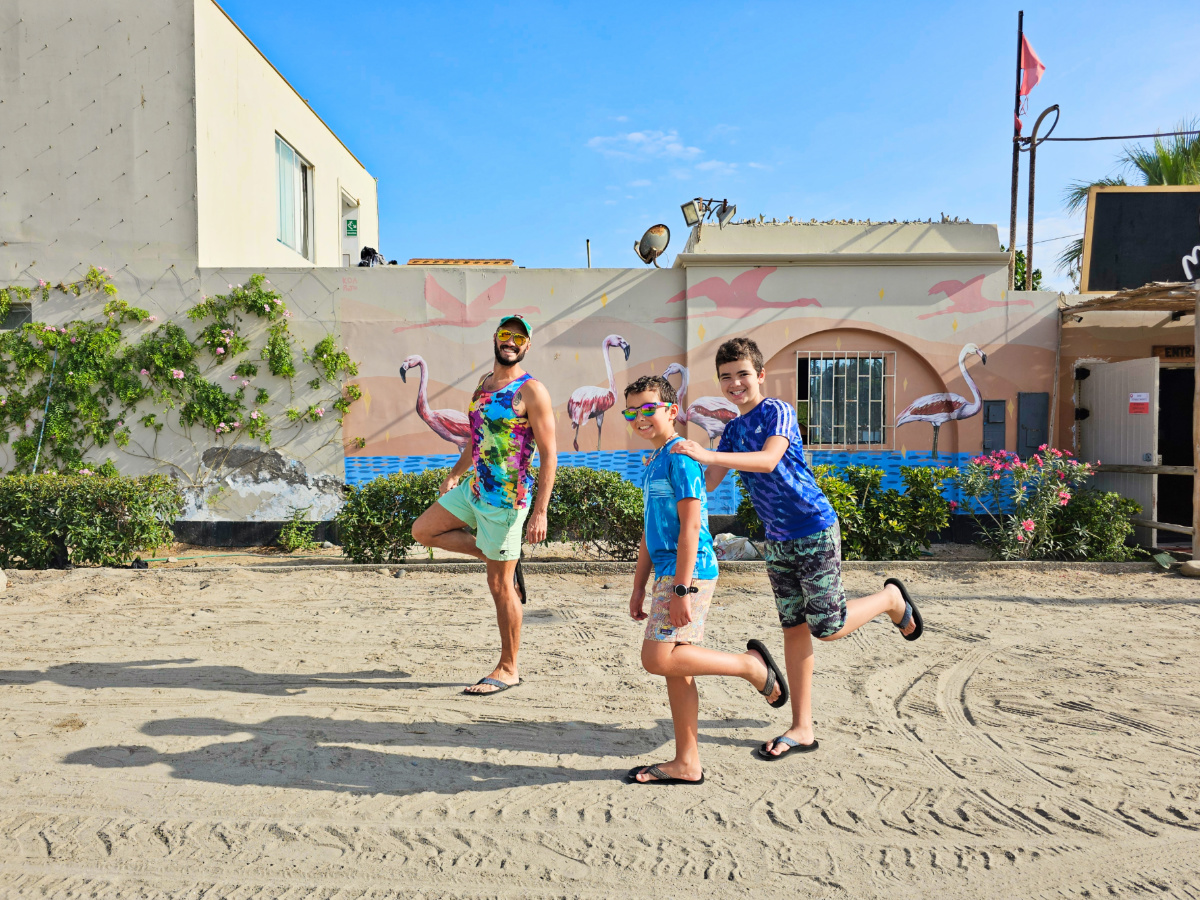
Ballestas Islands
Just off the coast of Paracas is one of my favorite wildlife sites on earth. I geek out over birds and other animals, so getting to visit the Ballestas Islands was a Peru trip highlight for me. Part of the Peruvian national parks system, the islands are a preserve and people aren’t allowed on them anymore, except for research purposes. So how do you actually visit the Ballestas Islands?
Book our exact Ballestas / Paracas Reserve tour here!
From the pier in Paracas you’ll board a tour boat (there are several companies) and head out to sea. You’ll see the fascinating landmark, La Candelabra, in the dunes as you make your way to the islands, and then as you approach you’ll start to see sea lions. Once there, it’s time to start wildlife watching. For us, the highlight was the humboldt penguins. We saw penguins in the wild!!
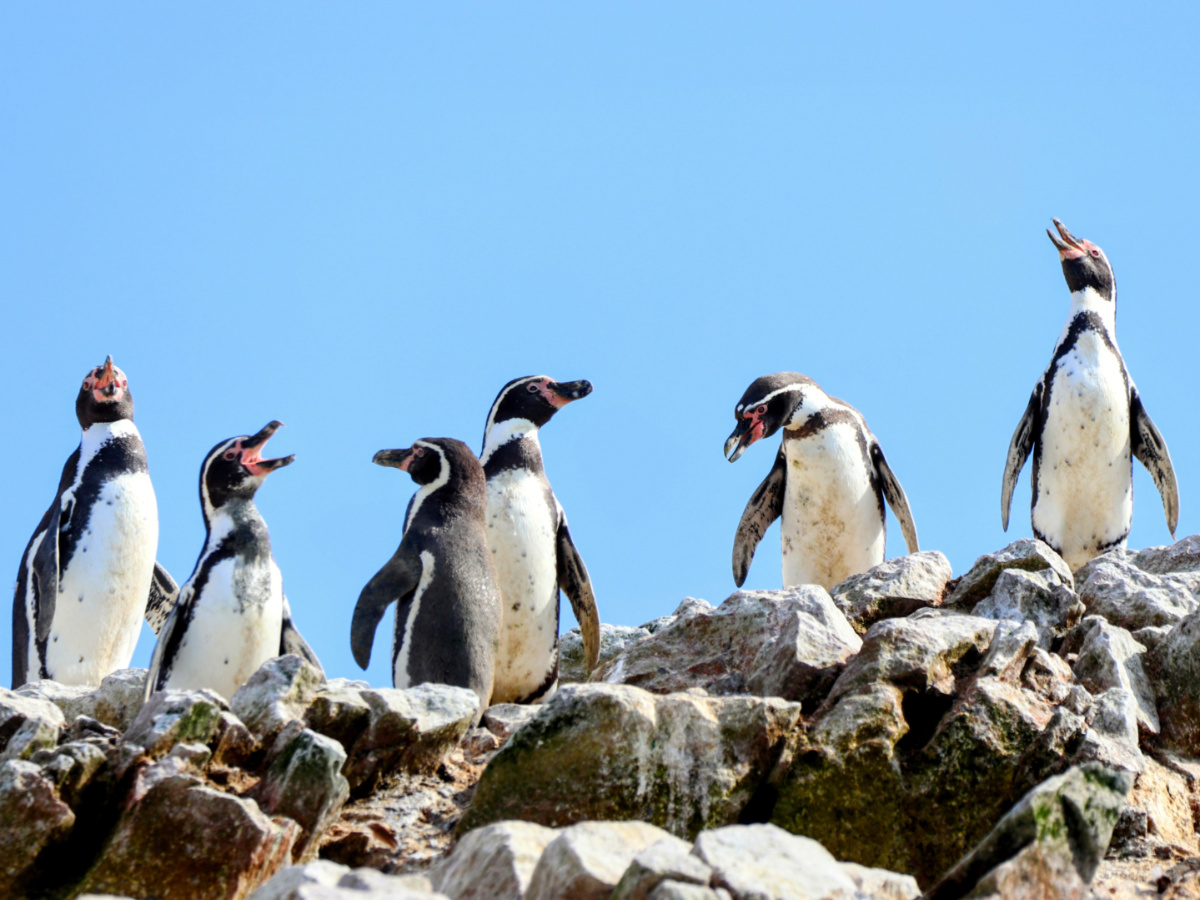
Here’s what to watch for when you do the boat tour to the Ballestas Islands:
- Humboldt penguins
- Lobos marinos aka the Southern sea lion
- Inca terns
- Gray boobies
- Cormorants
- Peruvian pelicans and more
For the kids, their favorite part was actually visiting Maternity Beach. This part of the Ballestas Islands is where the sea lion colony has its babies and there are hundreds of animals on the shore and in the water. There were countless baby sea lions and it was adorable.
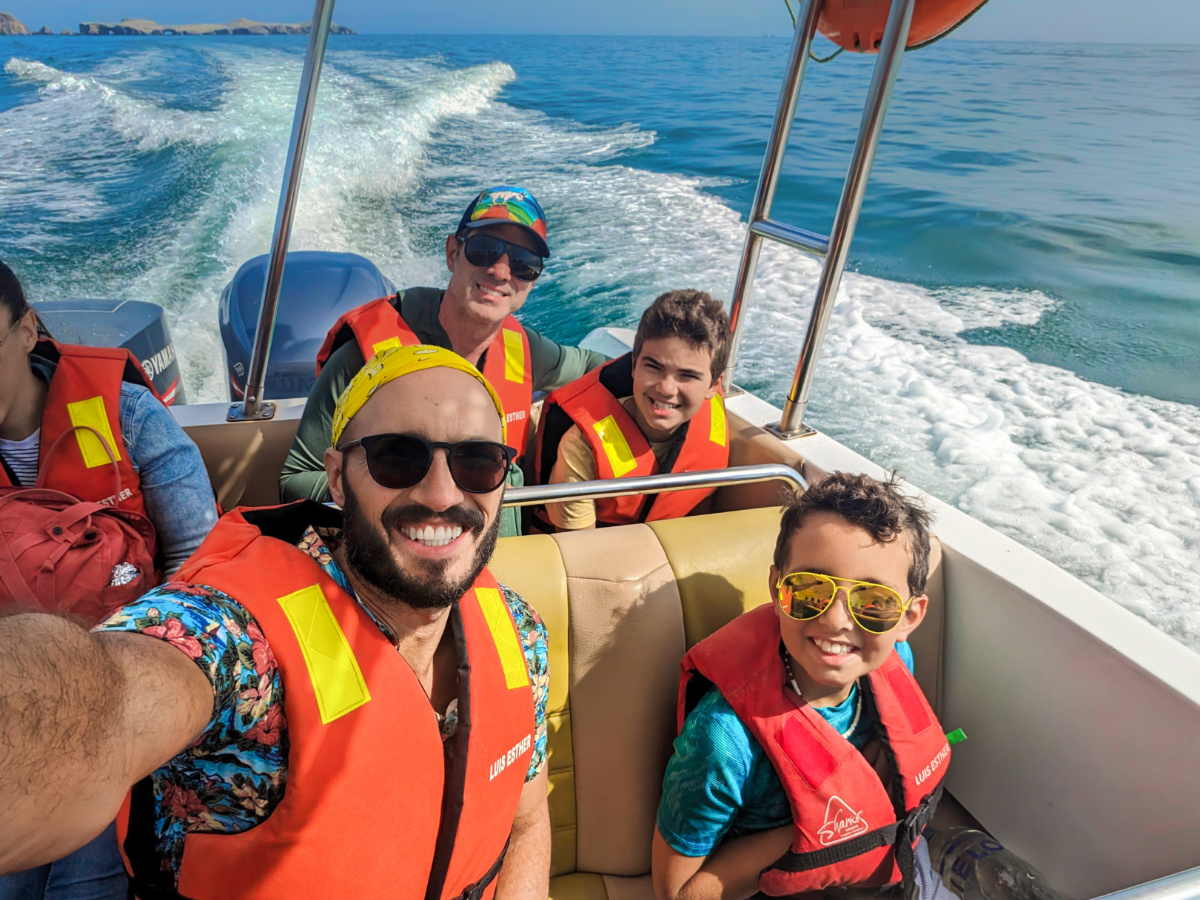
Paracas National Reserve
I had no idea how cool the Paracas National Reserve was going to be. I had seen photos but pictures never really do justice for certain places. The desert as it meets the ocean, both as beaches and sea cliffs is just amazing. Vast expanses of sand dunes with zero vegetation and seemingly no wildlife is really something to take in. It’s fun to explore though, as there are quite a few interesting sites to visit within the Paracas National Reserve.
Oh, and there are flamingos! I know! Pair a visit to the Paracas National Reserve on the same day with the Ballestas Islands and you’ll get to have a day that includes both flamingos and penguins on your Peru trip. Something that really wowed me about this area was how untouched it seems, and perhaps that’s just the nature of the desert, but it was very unique to experience.
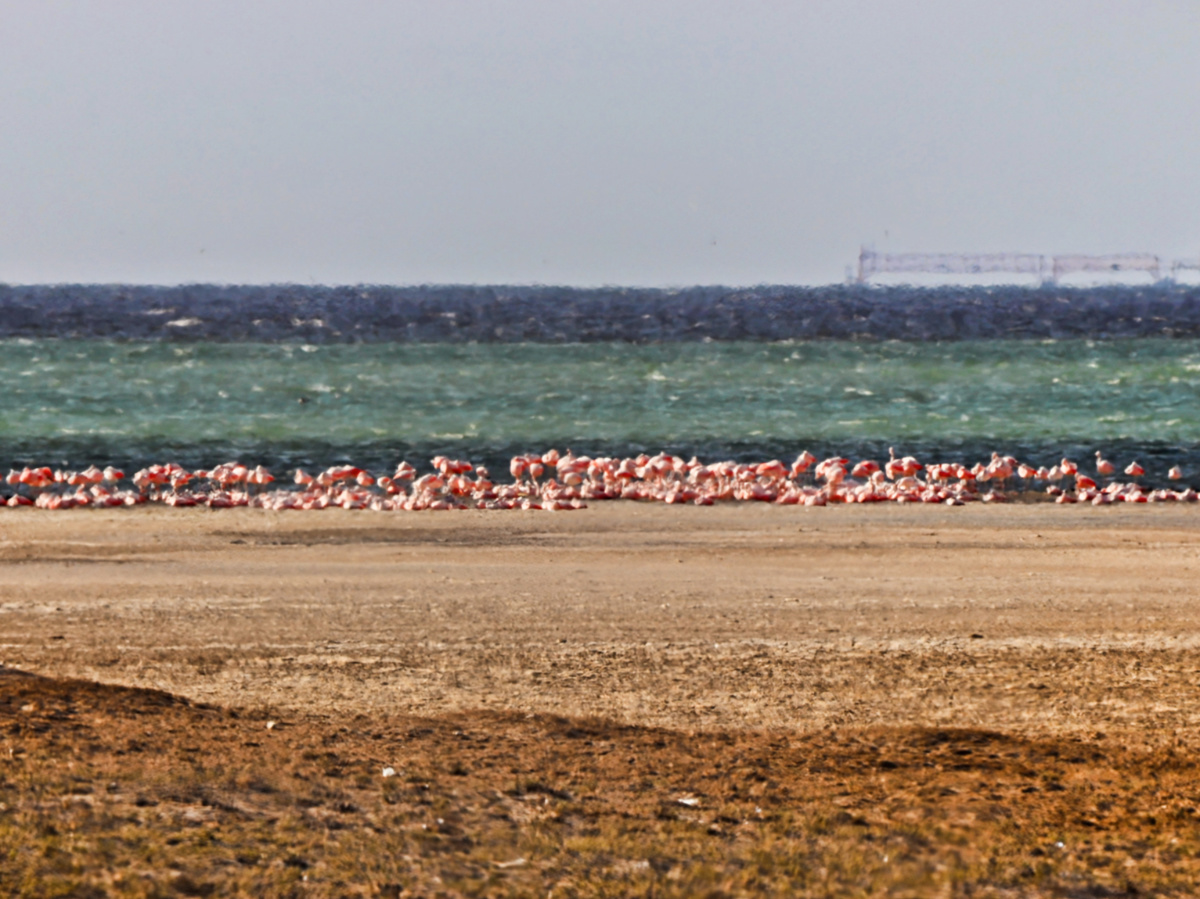
Add the Paracas National Reserve to your two weeks in Peru itinerary to get in some quality beach time. There are beaches here, both for viewing AND for swimming. While you’re not permitted to swim at the red sand beach or the beaches at Cathedral Rock, Playa La Mina is awesome with wonderfully clear water and perfect small waves. There is a fee to use the beach even if you’ve already paid entry to the National Reserve, so have a few soles ready.
Tip: if you’re limited for time, you can book a tour that covers both the Ballestas Islands and the Paracas National Reserve in the same day. This tour includes both areas.
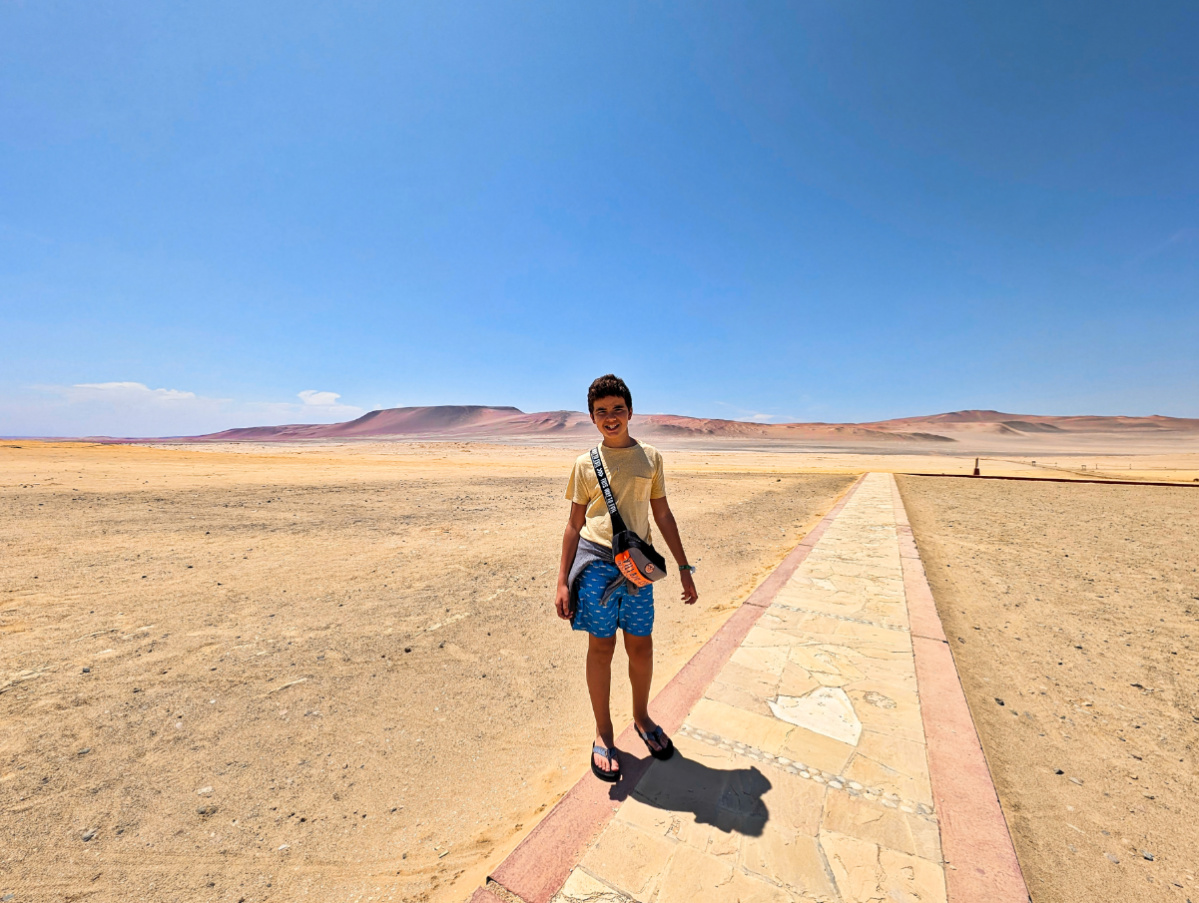
Visiting Ica and Huacachina Oasis
To add onto your time in Paracas, head to Ica. Ica is a larger city with a historic core and great restaurants. It’s half the size of Cusco with about 283k residents. There are a few cool museums, in particular El Museo de Javier Cabrera where you can see countless etched/carved glyphtoliths from pre-Inca times. Ica has historic sites, a cool old cathedral and more.
Just outside of the city is why most tourists head to Ica: the Huacachina Oasis! This is a natural oasis in the desert and it’s beautiful. It’s built up around the edge now, so there are hotels and restaurants, but the phenomenon of the oasis is still very cool and unique. If you tell somebody that you’re heading to Huacachina, no doubt they’ll say “Ooh, are you going sand boarding?!” Sand boarding is a very popular thing to do when you visit Huacachina. It’s just what it sounds like: snowboarding but on sand dunes. If this is on your Peru to-do list, we recommend booking a tour to visit Huacachina so you can enjoy the experience with a guide and the proper gear.
When you’re done visiting Paracas and Ica, it’s time to head back north to Lima to continue on with your two week Peru trip. I think this part of the trip really is a great way to feel refreshed after the Andes mountains, and you’ll be able to head to the Amazon with lots of energy and excitement!
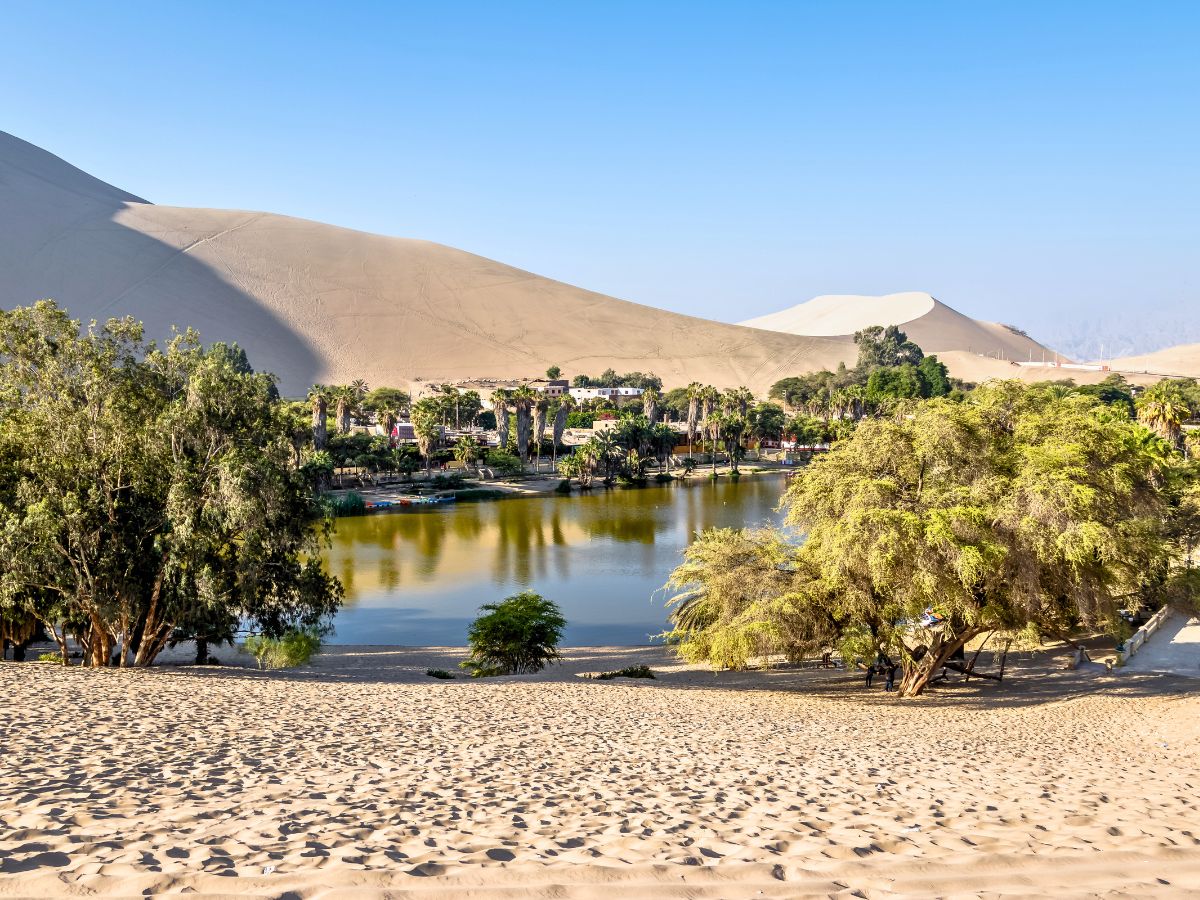
The Amazon River and Rainforest
Our time in the Amazon rainforest was amazing! This was all of our favorite part of our two weeks in Peru. A lot of people think of visiting the Amazon as being something you do when you go to Brazil, but it’s actually very easy to do in Peru and there are lots of wonderful options for how to go about it.
Join us on a group trip to the Peruvian Amazon!
We really enjoyed exploring the Amazon river and rainforest. It was the best part of our Peru trip. Be sure to listen to our podcast episode all about it!
Getting to the Amazon
To get to the Amazon from Lima or anywhere else in Peru, the easiest way is to fly to Iquitos. You cannot drive to Iquitos, Peru, but must either fly or arrive via boat on the Amazon river. To fly to Iquitos, you have to leave from Lima. There are some small regional flights to even smaller towns, but from anywhere a tourist might be, the only option is to go from Lima. Don’t worry, it’s a cheap flight and there are a few every day.
Iquitos is actually a large city, even if it doesn’t seem like it when you land at the tiny airport. Iquitos is larger than Cusco with nearly 500k residents in the city and surrounding area. It’s the launch point for exploring the Peruvian Amazon, including doing one of the many multi-day Amazon River cruises. For us, we were picked up from the airport by our driver from our lodge and then continued on an hour and a half drive to the town of Nauta, where we boarded a small passenger boat for a 45 minute ride south on the Amazon River, and then to our accommodations.
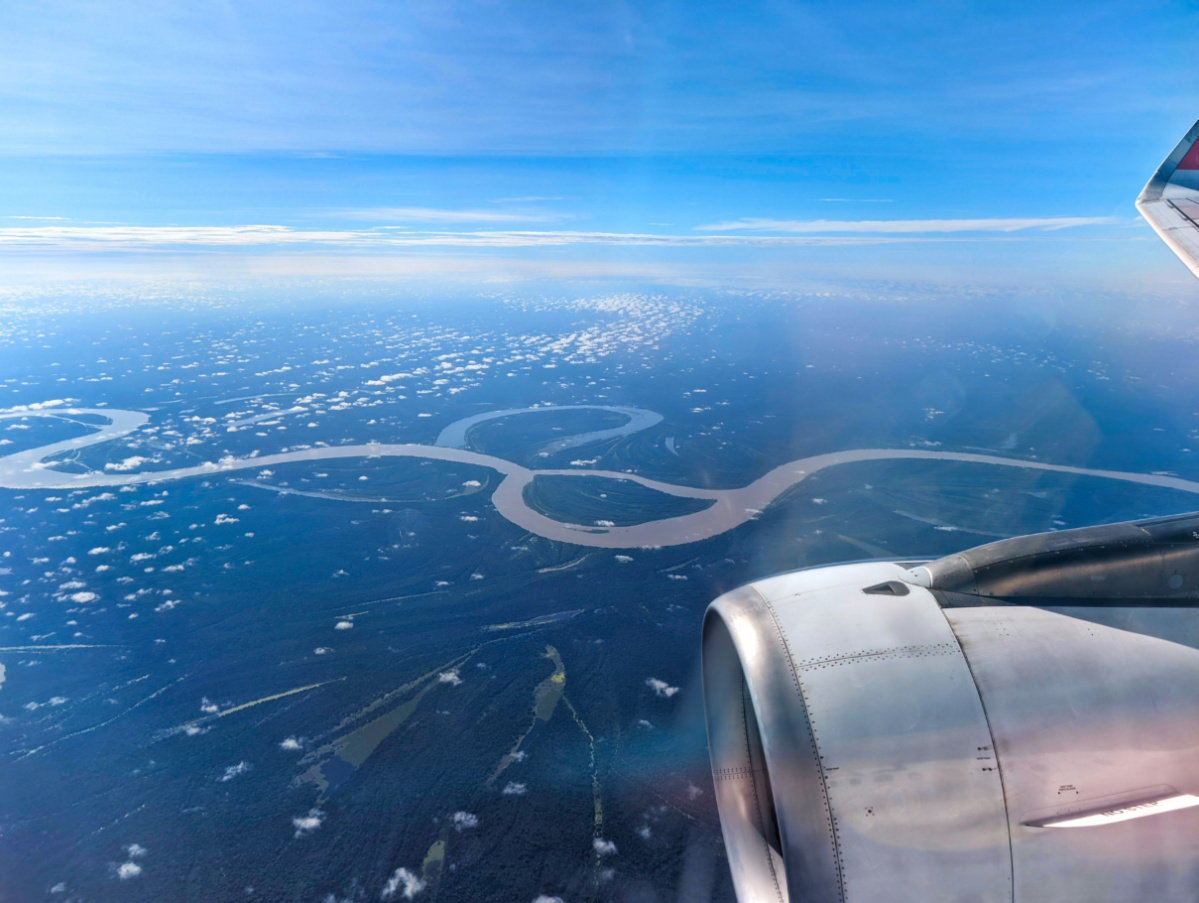
Activities in the Amazon Jungle
Wherever you’re staying for your Peruvian Amazon adventure, you’ll find a variety of activities. Of course the exact execution of the many adventures you’ll find in the Amazon will vary depending on where you’re staying for this part of your Peru trip or who you’re doing your daily excursions through, but you should be able to enjoy AT MINIMUM the following things to do:
- Photo safaris
- Guided bird and wildlife watching
- River cruising (day trips)
- Canoeing and kayaking
- Jungle walks / hikes
- Fishing trips (including piranhas)

Everybody has a different reason for wanting to spend time in the Amazon Rainforest, so as you’re planning your time, do what’s most important to you! For us, we were mostly excited for seeing wildlife of every sort, so we did photo safaris every day and were treated to monkeys, sloths, toucans, macaws and so much more. I can’t imagine another Peru trip without this experience!
Yes, there are mosquitos, but with some planning you’ll be able to enjoy exploring the jungle and cruising along the river without suffering. A combination of bug spray, wearing appropriate clothing to cover as much skin as possible, and even wearing mosquito net jackets can all be good ways to stay itch free. The mosquitos aren’t a problem everywhere or every time of day, but if you’re out at sunset or after, and you’re in the slower flowing parts of the Amazon tributaries or on a lake, the bugs are intense. Just be prepared and you’ll be fine.

Staying at the Treehouse Lodge
Our whole two week Peru itinerary began with us planning our adventures around getting to stay at the Treehouse Lodge in the Amazon rainforest. We had seen pictures online and watched videos of this awesome looking place, so we did more research. Staying at the Treehouse Lodge means that you have an all-inclusive experience where your meals, lodging and ALL excursions are included in your cost.
Our accommodations in our treehouse were perfect for our family of four, including a bathroom in our treehouse, seating, mosquito netting, fans, and getting to shower and watch toucans outside the window. It was wonderful, to say the least. The food was also great, with three meals each day using locally sourced food, prepared in fresh, healthy, Peruvian styles. (Alcohol is the only thing not included, but there is a bar at the Treehouse Lodge.) Across our whole two week Peru trip this was the most magical and comfortable accommodations we had.
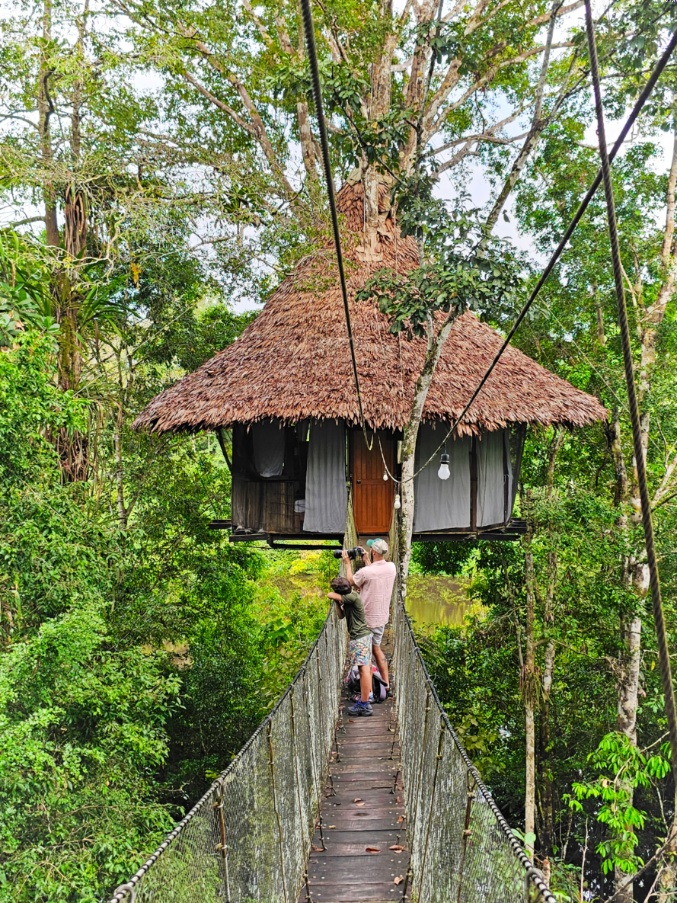
Our daily excursions were amazing. We had our own dedicated guide and river captain, Edgar and Roger. They took great care of us and made sure that we saw the absolute most wildlife and habits that we could in the Amazon Rainforest. We went out at sunrise, morning, midday and sunset. We went fishing multiple times and saw more monkeys and sloths than we could keep track of. Our experience was unmatched in any travel we’ve ever done.
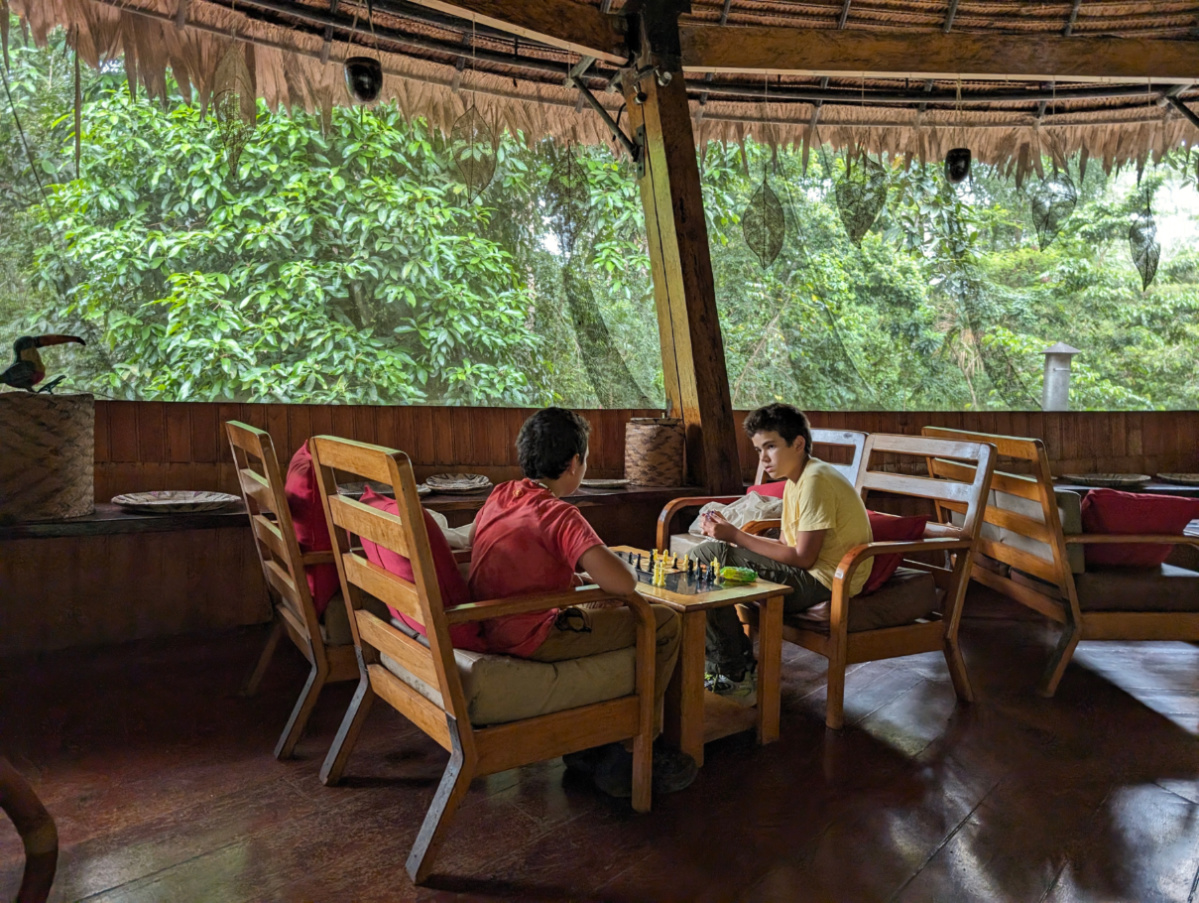
Are you excited to plan a two week Peru trip?! You should be. This itinerary really is solid for having diverse experiences no matter what your interests or travel chops lead you to. Peru is fun, beautiful and unlike what you expect. Please, if you have any questions about either this two week Peru itinerary, planning your trip, or if you want to join us on an upcoming Peruvian Amazon adventure, leave a comment or send us a note. We’re happy to help!
